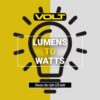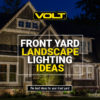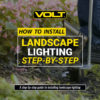When selecting 12V light bulbs for landscape lighting, they should meet the following minimum requirements:
- Designed for use in damp locations so it can handle the challenges of surviving in an outdoor environment
- Have an ETL and UL Listing
- If LED, it should have a conformal coating on the circuitry of the bulb to protect the sensitive computer components from corroding or being damaged by moisture
Terms to Know

Lamp Type:
A lamp is a technical term for a bulb. VOLT® offers a range of lamp types – MR16, G4 BiPin, PAR36, MR11, MR8, S8 & T5 wedges.

Light Source:
Light sources used in VOLT® Lamps are Tungsten Halogen and LED. LEDs are the preferred source.

Light Output & Brightness:
Light output is the measure of light energy exiting a lamp (lumens). Brightness is the subjective perception of the light level by the viewer.

Beam Angle:
A measure of the projected conical angle of a light beam that determines the beams width.

Color Temperature (CCT):
An indication of the extent of bluish or yellowish tint present in white light.

Color Rendering Index (CRI):
An indication of how well a light source illuminates a subject to reveal accurate colors and hues – compared to incandescent light.

LED Lamp Life (L70):
The predicted length of time that a lamp retains a useful light output.

Electrical Measurements:
These include voltage, wattage, amperage, and power factor.
Bulb Types
VOLT® manufactures a variety of bulbs, each of which is available in incandescent and LED versions.

PAR36 Bulbs (Parabolic Aluminized Reflector with 36/8” diameter) – This was the first lamp used in low voltage landscape lighting back in the 1950s. Also called a Sealed Beam Lamp, PAR lamps are durable and watertight – making them ideal for below-ground fixtures. VOLT® LED PAR36 bulbs represents a dramatic improvement in the performance of these lamps.
MR16 Bulbs (Multifaceted Reflector with 16/8” diameter) – This is the most commonly used lamp for landscape lighting. Incandescent versions feature an internal faceted reflector that shapes the beam. Newer LED versions tend to not have reflectors and instead use columnar optics that produce a more evenly dispersed beam. VOLT® has the industry’s largest selection of MR16 LED lamps to accommodate the widest variety of lighting designs.
MR11 Bulbs (Multifaceted Reflector with 11/8” diameter) – Similar in appearance to the MR16, but much smaller. The small size of the MR11 makes it ideal for very compact fixtures, but it is not available in very high light outputs.
G4 Bi-Pin Bulbs – This lamp (like the MR16 and MR11) has two pins that are plugged into a socket. The pins, however, are narrower, and the lamp body may have several different shapes. The shapes are important since they determine whether or not the lamp fits into a specific fixture. Check fixture specifications for more details.
S8 and T5 Wedge Base Bulbs – While these lamps are not used in VOLT® fixtures, they are commonly used by other manufacturers. The S8 type has a larger base, while the T5 is much smaller. Check fixture specifications for correct lamp type.
SCB Bulbs – While these lamps are not used in VOLT® fixtures, Single Contact Bayonet (SCB) Lamps are commonly used by other manufacturers. Unlike pin-type or wedge-type lamps, these are pushed into the socket, then turned to lock in place. Check fixture specifications for correct lamp type.
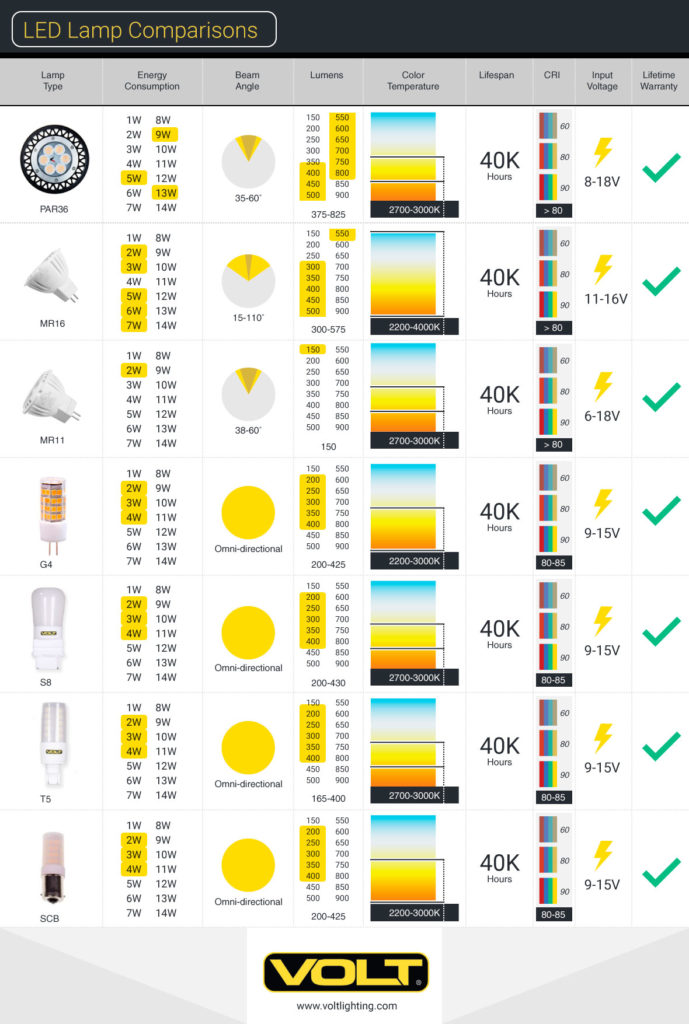
Light Source – LED vs. Halogen
Prior to the LED revolution, tungsten halogen lamps (also known as quartz halogen) were the primary light source for landscape lighting. These lamps had better energy efficiency than older incandescent types, but they still produced a great amount of heat, had limited life (2,000 to 10,000 hrs.), and required a very narrow voltage range (10V to 12V) for normal operation.
Now we have a much better light source, Light Emitting Diodes (LEDs). LEDs can achieve the same light output with up to 85% less energy (watts). They also produce far less heat than quartz halogen and have a wider acceptable voltage range (8V to 15V). Perhaps the most astonishing difference is longevity. VOLT® LED lamps to have an estimated life of between 40,000 hrs. and 60,000 hrs. They are essential “lifetime” light sources.
While the initial investment in LED lamps is somewhat greater than with low voltage halogen bulbs, that investment is paid off very quickly and results in a lighting system that requires no bulb replacements – ever.
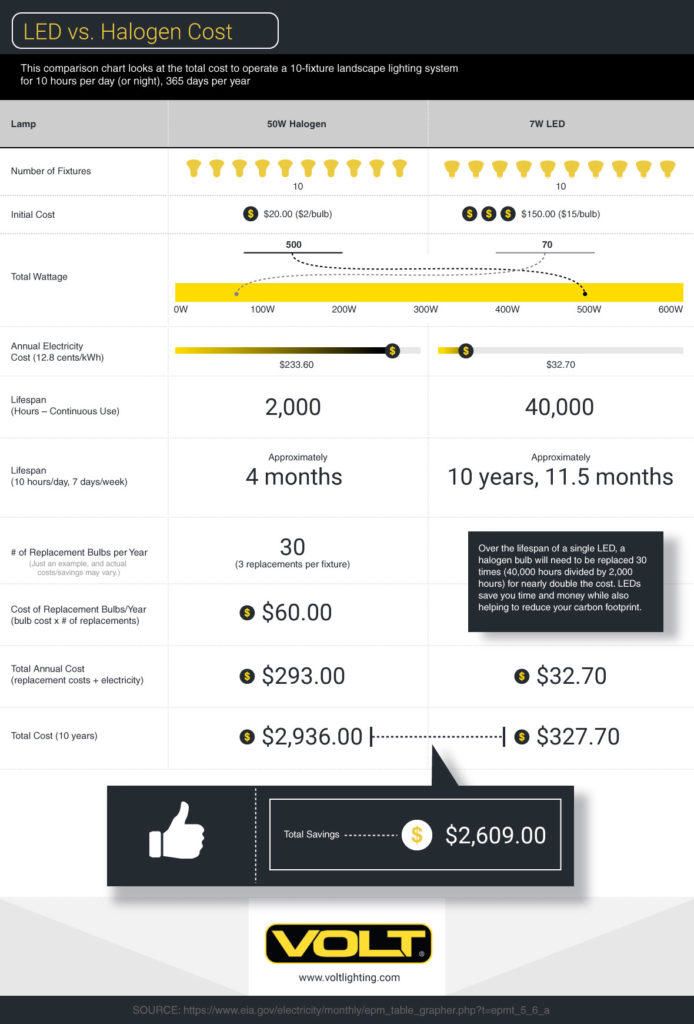
Light Output & Brightness
When we compare the output of lighting fixtures, we need to use the correct language. The light that exits a lighting fixture is called “light output.” It is measured in lumens (units of light energy).
If you look at the specifications of a fixture, you will see such terms as “fixture lumens” or “fixture output.” These both describe the same thing – a measurement of lumens that exit the fixture.
Lamps also have their own lumen specifications. However, lamp lumens only apply to the light output of the lamp when it is not in a fixture. Once you put the lamp in a fixture, not all of these lumens exit the fixture. Some manufacturers claim a certain number of lumens for a fixture, but they neglect to say whether these are lamp lumens or fixture lumens. Keep this in mind when comparing fixtures.
Is brightness the same as light output? No, light output is an objective measurement – it can be measured with a light sensor. Brightness, on the other hand, is subjective. If you look at a lit bulb in a dark room, it seems very bright. If you look at the same bulb outdoors on a sunny day, it will seem very dim. That’s why lighting pros avoid the terms “bright” or “dim.” Instead, they refer to differences in light output.
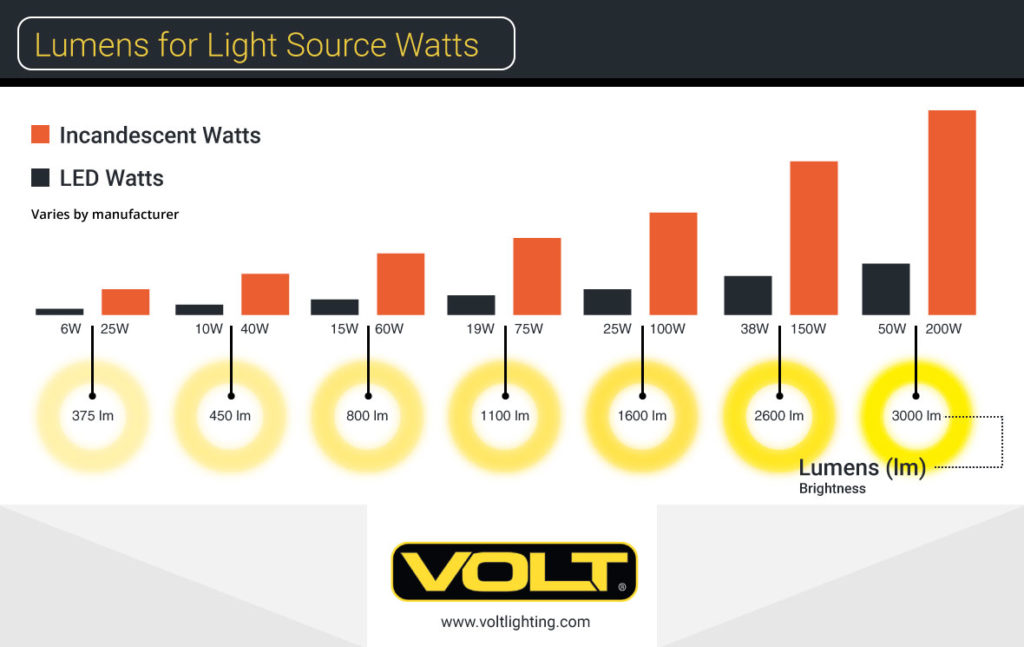
Wattage to Lumen Equivalents
Back in the days when most lights were of the incandescent filament types, wattage was a good way to describe light output. Everyone knew what a 40W or 60W bulb looked like. If you wanted a bright bulb for reading, you would select the 60W. If you just needed a light for a hallway, 40W was probably enough.
That changed with the introduction of fluorescent and compact fluorescent (CFL) bulbs. A 20W CFL bulb had a light output equal to a 40W incandescent bulb. Now, with the introduction of LEDs, a 10W LED is equivalent to that same 40W bulb. Clearly, wattages are no longer a good way to assess light output. Instead, we use lumens.
Efficacy is used to describe lumens per watt. In simple terms, efficacy describes the power needed (wattage) to produce the amount of light (lumens). For instance, a fixture that is 5 watts and produces 500 lumens has an efficacy of 100 lumens per watt. Likewise, a fixture that produces 300 lumens at 3 watts also has an efficacy of 100 lumens per watt. A fixture that produces 300 lumens at 2 watts has an efficacy of 150 lumens per watt. So the actual wattage used may not necessarily affect efficacy. Instead, efficacy will vary due to multiple factors related to the light source, such as how hard the LED is being driven and how well the heat it produces is dissipated.
Eventually, we will learn to assess light output with lumens – wattages will no longer interest us. In the meantime, the following table is a rough approximation of lumens and wattage equivalents. Keep in mind, however, that this table can be misleading because of individual lamp characteristics. It’s common, for instance, that certain LED fixtures are far more efficient and produce much more lumens than their incandescent equivalents.
Lumens and watts conversion charts for your reference: Data from Federal Trade Commission.
Beam Angle
Beam angle is an indication of the width of a beam of light. For example, lamps can have very narrow, narrow, wide, or extra wide beams. These terms don’t actually describe the distance from one side of the beam to the other. Instead, they describe the angles measured from the center of the beam to its edges.
The way it’s measured is to first find the brightest part of the beam (usually at its center) and to record that value (in candelas). Then the light meter is moved towards one edge of the beam until the candela reading is one-half the center reading. The angle between the center line and the edge line is measured. This is repeated on the opposite side of the beam, then the two angles are added together. The result is the beam angle.
 How do you select beam angles? Here are the common beam angles and suggested uses:
How do you select beam angles? Here are the common beam angles and suggested uses:
- 80º (Very Wide Flood) – Use for flooding a wall with light, or for any application that needs a wide expanse of light.
- 60º (Wide Flood) – A good all-purpose beam angle that looks nice on house facades, plant material, and any application where you want fairly wide coverage. The use of this angle also avoids the projection of a noticeable cone of light on a surface – gives a more natural appearance to the illumination.
- 35º – 38º (Flood) – An ideal angle to use when lighting between windows on the front of a house, or when the object to be illuminated is not overly wide.
- 24º (Spot) – Projects a fairly narrow cone of light, best used on tall narrow objects such as columns and narrow trees. Avoid projecting onto wide surfaces since the narrow cone of light may seem overly artificial.
- 12º (Narrow) – An extremely narrow cone of light ideal for flagpoles, very tall palm trees, some columns, and other tall narrow objects. Be mindful that when all the light is concentrated in such a narrow cone, the luminance is extremely high – select lower output lamps if needed.
There are a few things to keep in mind about beam angles.
- Sometimes the beam angle sits near the edge of the visible beam (known as a hard cutoff). Other times, the edge of the beam is very diffused and spills past the beam angle. The preferred beam has a soft edge that extends a moderate distance from the beam angle and gradually blends into darkness – this is the type of beam found with VOLT® LED lamps. An excessive spill can lead to excessive glare.
- The use of a diffusion or spread filter can increase the beam angle and create a more evenly dispersed light.
The following filters can be used to modify the beam angle in VOLT® fixtures:
- Interchangeable Optics for Infiniti™ G2 Integrated LED Spotlights – Available in 12º, 24º, and 35º
- Wide Spread Flood Filters – Super-thin polycarbonate filters that increase beam angle to 80º
- Diffusion Lenses – For PAR36 & MR16 fixtures – cross-ridges increase beam angle without extensive diffusion
- Frosted Lenses – For PAR36 & MR16 fixtures – frosted surface increases beam angle and extensively diffuses the light
- Hex Louvre Lens – For PAR36 & MR16 fixtures – slightly reduces beam angle, makes beam edge harder with less spill past the edge to prevent direct glare
LED Bulb Color Temperature (CCT – Correlated Color Temperature)
While all landscape lighting uses white light sources, some of these sources have a warm hue (more yellow), others have a cool hue (more blue). This variation in yellowish or bluish hue is what determines color temperature.
Color temperature is expressed in degrees Kelvin (K). A warm white light might be 2700K – 3000K. A cool white source might be 4000K to 4500K. See the chart below for examples of varying color temperatures.
 How do you select color temperature?
How do you select color temperature?
- If you already have lighting on your property, you may want to keep the same color temperature throughout. (It can look strange to use different color temperatures among nearby lights.)
- 2200K: Very warm (similar to candlelight) and can be used for special romantic effects in patio or deck settings. This light is also close to the color of sodium lamps used in some streetlights – so designers may want to match that effect.
- 2700K: Most common in landscape lighting (very warm and welcoming).
- 3000K: Preferred by some because they like the cooler look, especially when lighting vegetation.
- 4000K: Sometimes used for downlights from trees, because it is similar in color to moonlight. Others prefer warmer colors for those lights.
Color Rendering Index (CRI)
If incandescent (filament-based) lights illuminate a scene, you will perceive (among the lit objects) certain colors and hues. If you change the light source to a non-incandescent type, you may find that the colors and hues look different.
The ability of a light to accurately render colors and hues (compared to incandescent lighting) is called the color rendering index (CRI). A perfect CRI would be 100. Most high-quality LEDs have a CRI of over 80. CRI’s less than that should be avoided.
LED Lamp Life (L70)
Unlike older incandescent and fluorescent lights, LEDs do not typically burn out. Instead, they diminish in light output over time. That’s why LED lamp life is determined by how long it maintains a useful light output.
The most accepted measure of when the LED has reached the end of its useful life, is when the light output has diminished to 70% of its initial output. This is termed L70.
Keep in mind that L70 is a predicted time based on the estimated temperature of the LEDs during operation. If an LED operates in a poorly designed fixture, it may overheat and diminish in brightness relatively quickly. There are also other factors concerning the components of the LED driver that may cause premature failure of the LED.
For these reasons, L70 is not a good measure to use when comparing fixtures.
Electrical Measurements
- Wattage: The energy consumption of the lamp or fixture. This is what is recorded on your home’s electrical meter and what appears on your electrical bill.
- Amperage: Indicates the strength of the electrical current required to power the lamp or fixture. Important for larger systems so that wire sizes and transformers can be chosen correctly.
- Power Factor: This is a value (from 0 to 1) that arises from the behavior of the LED driver circuitry. It affects how wires and transformers are sized. Higher power factors are preferred to lower ones. But this is not a useful value to compare lamps & fixtures.
- VOLT-AMPS: This is the value obtained by dividing the wattage by the power factor. It is used to determine wire and transformer sizing.
- Operating Range: This is the safe range of voltage that can be applied to a lamp or fixture.
